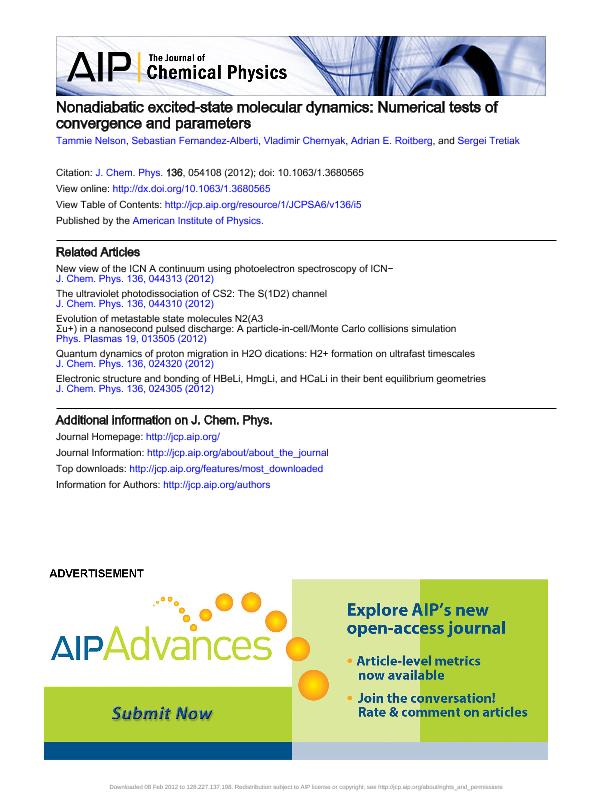Artículo
Nonadiabatic excited-state molecular dynamics: Numerical tests of convergence and parameters
Nelson, Tammie; Fernández Alberti, Sebastián ; Chernyak, Vladimir; Roitberg, Adrián; Tretiak, Sergei
; Chernyak, Vladimir; Roitberg, Adrián; Tretiak, Sergei
 ; Chernyak, Vladimir; Roitberg, Adrián; Tretiak, Sergei
; Chernyak, Vladimir; Roitberg, Adrián; Tretiak, Sergei
Fecha de publicación:
01/2012
Editorial:
American Institute of Physics
Revista:
Journal of Chemical Physics
ISSN:
0021-9606
Idioma:
Inglés
Tipo de recurso:
Artículo publicado
Clasificación temática:
Resumen
Nonadiabatic molecular dynamics simulations, involving multiple Born-Oppenheimer potential energy surfaces, often require a large number of independent trajectories in order to achieve the desired convergence of the results, and simulation relies on different parameters that should be tested and compared. In addition to influencing the speed of the simulation, the chosen parameters combined with the frequently reduced number of trajectories can sometimes lead to unanticipated changes in the accuracy of the simulated dynamics. We have previously developed a nonadiabatic excited state molecular dynamics methodology employing Tullys fewest switches surface hopping algorithm. In this study, we seek to investigate the impact of the number of trajectories and the various parameters on the simulation of the photoinduced dynamics of distyrylbenzene (a small oligomer of polyphenylene vinylene) within our developed framework. Various user-defined parameters are analyzed: classical and quantum integration time steps, the value of the friction coefficient for Langevin dynamics, and the initial seed used for stochastic thermostat and hopping algorithms. Common approximations such as reduced number of nonadiabatic coupling terms and the classical path approximation are also investigated. Our analysis shows that, at least for the considered molecular system, a minimum of ∼400 independent trajectories should be calculated in order to achieve statistical averaging necessary for convergence of the calculated relaxation timescales.
Palabras clave:
nonadiabatic molecular dynamics
,
excited states
Archivos asociados
Licencia
Identificadores
Colecciones
Articulos(SEDE CENTRAL)
Articulos de SEDE CENTRAL
Articulos de SEDE CENTRAL
Citación
Nelson, Tammie; Fernández Alberti, Sebastián; Chernyak, Vladimir; Roitberg, Adrián; Tretiak, Sergei; Nonadiabatic excited-state molecular dynamics: Numerical tests of convergence and parameters; American Institute of Physics; Journal of Chemical Physics; 136; 5; 1-2012
Compartir
Altmétricas



